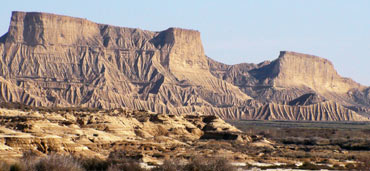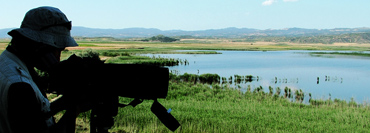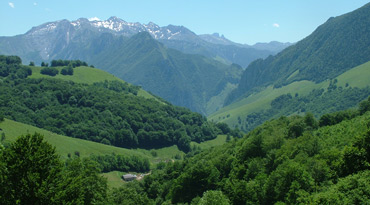I’m biased about birding in Navarra, it’s true…

The Bardenas Reales
… and perhaps that’s a good enough reason for me to answer the question put to me recently “Where would you go birding in Navarra?”
Navarra is a small part of Spain, and to give you a very rough idea it houses the westernmost parts of the Pyrenees and the Ebro valley. I lead birding tours to Navarra and quite surprisingly those birding tours haven’t been fully booked for the last two years. If after reading this short piece you are half as surprised as I am at this situation then I’ll be satisfied.
In my mind’s eye I can draw a line transect from the Bardenas in the south of Navarra to the Pyrenees in the north. Now the remarkable thing revealed by such an exercise is that the drive between one and the other can be done in less than two hours and takes me from sun-baked dusty plains, past gorges and lakes, to lush deciduous forest and snow-covered peaks.
The Bardenas Reales, when not being used for military manouevres, is an excellent place to concentrate a patient search for larks (personally I’ve seen 7 species here, including the much-vaunted Dupont’s Lark), as well as both species of European sandgrouse. With a bit of luck you could also expect Black Wheatear, Black-eared Wheatear, Spectacled Warbler, and a few species of raptor at least.

Birding at Pitillas lagoon
The second point on my carefully-selected transect would be Pitillas lagoon. Once away from the road one of the most striking things about Pitillas is its placid, scenic setting. I often feel that this is one of those places where the birds now and then take second place to the sensation of just being there, especially if the sun is shining, as it should be. Of course there are interesting birds: the sheer din kicked up by singing Skylarks and Calandra Larks is at times overbearing; small parties of Bearded Reedlings often ping enough to attract my attention to the surrounding reedbeds; then on or next to the water itself I would expect to find a good variety of water birds, including Red Crested Pochard, Black-necked Grebe, Purple Heron, ducks and a few waders perhaps.
Leaving Pitillas but before going too far I would set my sights on birding through a patch of Mediterranean scrub: this is often good for warblers like Sardinian and Subalpine Warblers, Cirl Buntings, Quails in the cereal fields, and maybe a Woodchat Shrike or two, a hovering Short-toed Eagle and the music of the lonely-sounding Woodlark.
Then comes Lumbier gorge. Easy birding on a flat, level walk with the promise of views of Red-billed Chough, Rock Sparrow, Alpine Swift, Blue Rock Thrush and plenty of Griffon Vultures at very close range; in the winter months there is always the lure of looking for, and hopefully finding, a Wallcreeper.

The Pyrenees are green green green in June
The Pyrenees now beckon, and probably with two main bird departments in mind: alpine species and woodpeckers. At the forefront of the former are species such as Lammergeier, Alpine Chough, Alpine Accentor, Citril Finch, Ring Ouzel and possibly even Snowfinch; for the latter I’d be very content to see Wryneck and both Black Woodpecker and the rare White-backed Woodpecker on the same trip.
Then for a fuller picture of the naturalist in Navarra I really should mention Great and Little Bustard on the plains, the meanders and gallery woodland of the lowland rivers, tributaries of the River Ebro, and the 50 species of butterflies we casually identified on our Ornitholidays tour last year, and without trying too hard. Hopefully it won’t be necessary to go into that kind of detail just yet, because I’m sure you already have the idea.
Leave a Reply